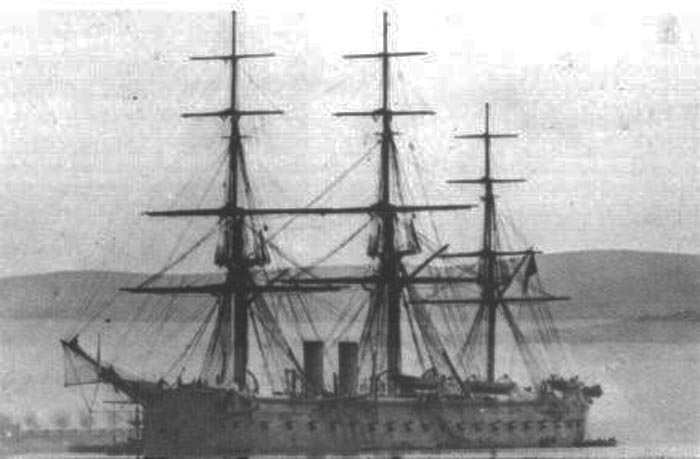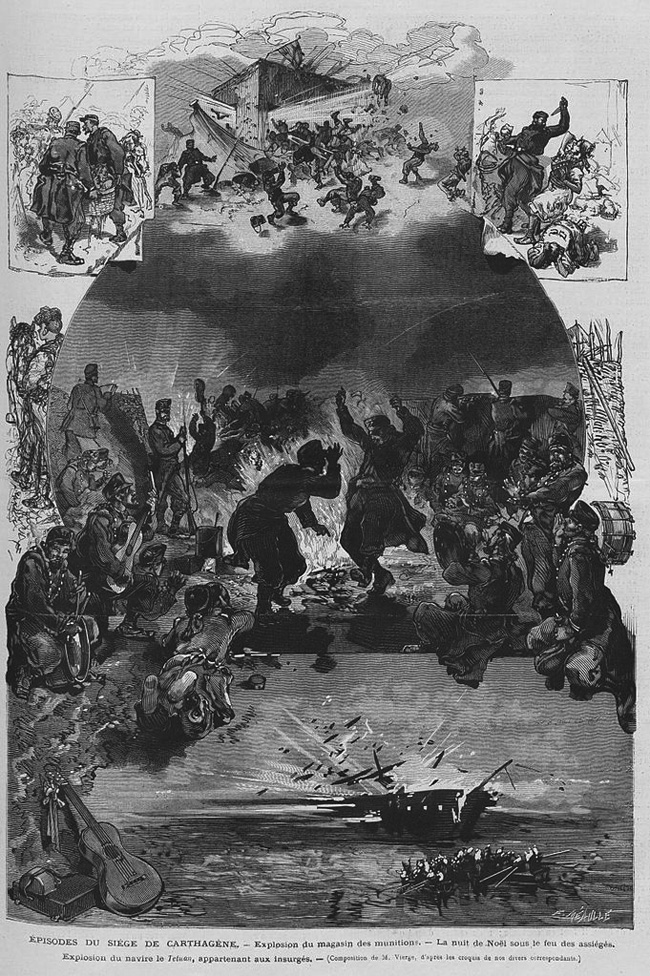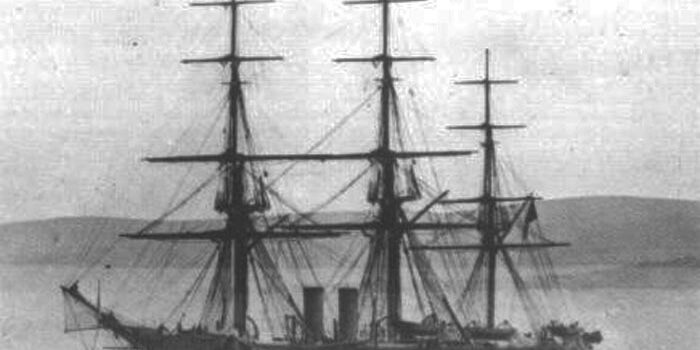Tetuán was the first Spanish-built Ironclad, the second in service with the Armada (Spanish Navy), designed on French plans but built at Ferrol, and faster than her sister Numancia. Her career included the Cuban squadron, the Glorious revolution, and the Canton of Carthagena uprizing, the Naval Battle of Portmán in which she was damaged. She had a short career indeed, burned in 1873 under battle damage repairs, probably by a saboteur, after just eight years of service. #armada #tetuan #ironclad #spanishnavy #ferrol
Development & Context
Spain in 1859 observed the French launching Gloire that year, and soon Britain answering with the massive iron-hulled Warrior class, and was caught off-guard, forced to reconsider its fleet composition, which was like all other nations, filled with ships of the line and frigates. The composition of the Armada at the time (see the to see here, was two 85-guns ships of the line four more ageing 80-74 guns, three large screw frigates and four sailing frigates, more sloops, corvettes, gunboats and bricks, notably to service its stil large empire.
Under Queen Isabel II, the navy advisor urged the funding of a vigorous naval program in 1861 to claim back strength, arguing for four broadside ironclads. Two were ordered in France, the first at La Seyne, and the second to be built in Spain at the Ferrol Royal Dockyard in Galicia, on the Atlantic coast, under French plans and guidance. This was Tetuán.
The Queen approved her advisors as having a fleet of armoured frigates, to restore the Armada as the world’s fourth-largest naval power again. Spanish shipyards however were stuck in traditional shipbuilding, and a general lack of industrial basis notably to provide wrought iron for armour plating, modern artillery, left to be desired and a long process with assistance of British and French shipyards and industries would be necessary to reach the desired standard.
Order and construction of Tetuán
While the project was drafted by the Directorate of Engineers, construction was authorized as the process was still ongoing, on November 29, 1860. Her keel was laid down on May 22, 1861, 3rd slipway at Ferrol shipyard. She was launched on March 19, 1863, so after two years, using wood from Spanish forest, still there from Philip II time forestry previsions for the Armada. After a prolonged commissioning given her novelty in Spain, lack of experience of the shipyard, she was eventually was delivered to the Navy on April 4, 1866, so six years after authorization, and to a record cost of 6,772,256 pesetas. Trials revealed however excellent seaworthy qualities, including under rig, an advantage for colonial missions. The name commemorated the battle of Tetuán, just fought by the Spanish expeditionary force with the fleet in a landing and won in 1860 as part of the Hispano-Moroccan War, versus tribal levies of Muhammad IV.
Design
Hull and general layout
Tetuán was not that different compared to her French-built sister Numancia. The latter was a straight-up copy of Couronne, while the latter was smaller. She measured 279 feet 1 inch (85.1 m) long at the waterline, for a beam of 55 feet 9 inches (17 m) and draft of 21 feet 8 inches (6.6 m). Displacement was 6,200 long tons (6,300 t) and 6,859 long tons fully loaded versus 7,305 t (7,190 long tons) for her sister. She was a single deck style frigate, with full armoured belt, and a three masted squared sailing rig plan.
Powerplant:
Tetuán was powered by a single horizontal trunk steam engine, driving a single four-bladed propeller. Steam was provided by eight boilers, all French provided like the engine. It was designed to produced a total output of 4,520 indicated horsepower (3,370 kW) for a top speed of 10 knots (19 km/h; 12 mph), however other sources speaks of 12 or even 13.5 knots. To compare her sister’s engine delivered 3,770 ihp (2,810 kW) for 12.7 knots. Long distance sailing was assured by her classic three masts rigging, and in addition 1,200 long tons (1,219 t) of coal were stored.
Armament:
She was armed with thirty 68-pounder smoothbore, rear-loading guns, typical of the day. This was of course this was to be revised in the future. To be precised these were forty 68-pounder (20 cm) Rivera-type cannons, all in battery, but on deck there were six lighter bronze cannons: Two swivel mount 15 mm (6 inches) smoothbore howitzers, as well as 2 rifled 120 mm cannons (4.5 inches) and two 80 mm (3 inches) cannons.
Armour:
Her waterline and Battery were protected by two 5.1 inches (130 mm) wrought-iron armor plating belts, with 13 cm iron plates (cast in France) all the way to the freeboard and down 1.20 meters below the waterline. There was no conning tower.
⚙ specifications |
|
| Displacement | 6,200 long tons (6,300 t) |
| Dimensions | 279 ft 1 in x 55 ft 9 in x 21 ft 8 in (85.1 x 17 x 6.6 m) |
| Propulsion | 1 shaft, Trunk steam engine, 8 boilers: 4,520 ihp (3,370 kW) |
| Speed | 10 knots (19 km/h; 12 mph) |
| Range | Unlimited with rig. |
| Armament | 30 × 68-pounder smoothbore guns |
| Protection | Belt: 130 mm (5.1 in), Battery: 130 mm (5.1 in) |
| Crew | 584 |
Career of Tetuan

Commissioned in 1866, she left Ferrol on March 31, 1866 to perform her sea trials, and initial training, colliding on shoald at the bottom of La Palma. She had no drydock repairs, and instead she was assigned to the Pacific Squadron in emergency, leaving Ferrol on April 6, 1866 to Cádiz, until it was discovered that damage to her hull was greater than expected so she was diverted to Toulon and spend dry dock time from April 23 to May 30, 1866 with revision to her machinery and a change of propeller as well, reaching 13.5 knots. She was back in Cádiz on June 7 but was no longer required as the Pacific squadron had already withdrawn from Peruvian and Chilean waters.
Next she was assigned to Havana station, leaving Cádiz on December 22, 1866 and joining Méndez Núñez division from Rio de Janeiro. She remained there until 1868 and under command of newly appointed captain Don Jacobo Mac-Mahon y Santiago she left Cuban waters on May 11, 1868 for New York, arriving on May 17. May, and entered Brooklyn Arsenal for extra repairs and maintenance until sailing back to Cádiz on July 15, 1868.
By September 1868 she was in the bay of Cádiz during the “Glorious” revlution, joining Brigadier Don Topete y Carballo, Juan Bautista, herself under command of Don Victoriano Sánchez Barcáiztegui, supporing the Army of Don Juan Prim, for the battle of Alcolea until Queen Isabel II was dethroned.
Later she was disarmed at the Cartagena arsenal, pending improvement works.

However soon the cantonal Revolution broke off, and she joined the cantonal squadron of Cartagena on July 12, 1873.
By mid-1873, indeed, the First Spanish Republic was beset with the Cantonal Revolution while at the same time being wrecked by the Third Carlist War. Revolutionaries seized Cartagena on 12 July but the bulk of the Mediterranean Squadron was still in port, notably Tetuán, Vitoria and Numancia, as well as the corvette Méndez Núñez. German and British ironclads, SMS Friedrich Carl and HMS Swiftsure seized Vitoria and a wooden steam frigate, flagged as “pirates” after threatening to bombard Almeria unless a ransom was paid. They were turned over to the national government on 26 September. Tetuan was also declared a pirate by government decree under Nicolás Salmerón.
She participated to the Naval Battle of Portmán, 6 October 11, 1873. On 11 October, all three Cantonist ironclads, Numancia, Tetuan, and Méndez Núñez were at sea when they were attacked near Cartagena by the government fleet, led by the returned Vitoria but the latter government kept their distance and did not allowed them to close in. Fire was exchanged still, and the rebels suffered 13 dead and 49 wounded in this skirmish, Tetuán being among them, damaged. She was later repaired until destroyed by fire:

Loss: On December 30, Tetuán was lost, burning under repairs, and then sinking during the siege of Cartagena Cantona uprizing after a fire broke out on board, which was suspected to be the work of a saboteur. This was two weeks before the city surrendered to government forces.
Read More/Src
Books
Greene, Jack & Massignani, Alessandro (1998). Ironclads at War: The Origin and Development of the Armored Warship, 1854–1891. Conshohocken, Pennsylvania: Combined Publishing. ISBN 978-0-938289-58-6.
Lyon, Hugh (1979). “Spain”. In Gardiner, Robert (ed.). Conway’s All the World’s Fighting Ships 1860–1905. Greenwich: Conway Maritime Press. pp. 380–386. ISBN 0-8317-0302-4.
de Saint Hubert, Christian (1984). “Early Spanish Steam Warships, Part II”. Warship International. XXI (1): 21–45. ISSN 0043-0374.
Silverstone, Paul H. (1984). Directory of the World’s Capital Ships. New York: Hippocrene Books. ISBN 0-88254-979-0.
Links
https://alojados.revistanaval.com/armada/buques_marinablindada/index.htm
https://alojados.revistanaval.com/armada/buques_marinablindada/tetuan.htm
http://www.armada15001900.net/navios/raesteiro.pdf
https://books.google.es/books?id=KMc2AAAAIAAJ&pg=PA214&lpg=PA214&dq=fragata+blindada+tetuan&source=web&ots=5Vx_nDyMPM&sig=zzXVaOFvexxF0jjTln6_wmjkC5E&hl=es#v=onepage&q=fragata%20blindada%20tetuan&f=false
https://web.archive.org/web/20120701162353/http://www.portalcultura.mde.es/Galerias/revistas/ficheros/RET_438.pdf
https://todoavante.es/index.php?title=Tetuan_(1866)




 Latest Facebook Entry -
Latest Facebook Entry -  X(Tweeter) Naval Encyclopedia's deck archive
X(Tweeter) Naval Encyclopedia's deck archive Instagram (@navalencyc)
Instagram (@navalencyc)





 French Navy
French Navy Royal Navy
Royal Navy Russian Navy
Russian Navy Armada Espanola
Armada Espanola Austrian Navy
Austrian Navy K.u.K. Kriegsmarine
K.u.K. Kriegsmarine Dansk Marine
Dansk Marine Nautiko Hellenon
Nautiko Hellenon Koninklije Marine 1870
Koninklije Marine 1870 Marinha do Brasil
Marinha do Brasil Osmanlı Donanması
Osmanlı Donanması Marina Do Peru
Marina Do Peru Marinha do Portugal
Marinha do Portugal Regia Marina 1870
Regia Marina 1870 Nihhon Kaigun 1870
Nihhon Kaigun 1870 Preußische Marine 1870
Preußische Marine 1870 Russkiy Flot 1870
Russkiy Flot 1870 Svenska marinen
Svenska marinen Søværnet
Søværnet Union Navy
Union Navy Confederate Navy
Confederate Navy Armada de Argentina
Armada de Argentina Imperial Chinese Navy
Imperial Chinese Navy Marinha do Portugal
Marinha do Portugal Mexico
Mexico Kaiserliche Marine
Kaiserliche Marine 1898 US Navy
1898 US Navy Sovietskiy Flot
Sovietskiy Flot Royal Canadian Navy
Royal Canadian Navy Royal Australian Navy
Royal Australian Navy RNZN Fleet
RNZN Fleet Chinese Navy 1937
Chinese Navy 1937 Kriegsmarine
Kriegsmarine Chilean Navy
Chilean Navy Danish Navy
Danish Navy Finnish Navy
Finnish Navy Hellenic Navy
Hellenic Navy Polish Navy
Polish Navy Romanian Navy
Romanian Navy Turkish Navy
Turkish Navy Royal Yugoslav Navy
Royal Yugoslav Navy Royal Thai Navy
Royal Thai Navy Minor Navies
Minor Navies Albania
Albania Austria
Austria Belgium
Belgium Columbia
Columbia Costa Rica
Costa Rica Cuba
Cuba Czechoslovakia
Czechoslovakia Dominican Republic
Dominican Republic Haiti
Haiti Hungary
Hungary Honduras
Honduras Estonia
Estonia Iceland
Iceland Eire
Eire Equador
Equador Iran
Iran Iraq
Iraq Latvia
Latvia Liberia
Liberia Lithuania
Lithuania Mandchukuo
Mandchukuo Morocco
Morocco Nicaragua
Nicaragua Persia
Persia San Salvador
San Salvador Sarawak
Sarawak Uruguay
Uruguay Venezuela
Venezuela Zanzibar
Zanzibar Warsaw Pact Navies
Warsaw Pact Navies Bulgaria
Bulgaria Hungary
Hungary

 Bundesmarine
Bundesmarine Dutch Navy
Dutch Navy Hellenic Navy
Hellenic Navy Marina Militare
Marina Militare Yugoslav Navy
Yugoslav Navy Chinese Navy
Chinese Navy Indian Navy
Indian Navy Indonesian Navy
Indonesian Navy JMSDF
JMSDF North Korean Navy
North Korean Navy Pakistani Navy
Pakistani Navy Philippines Navy
Philippines Navy ROKN
ROKN Rep. of Singapore Navy
Rep. of Singapore Navy Taiwanese Navy
Taiwanese Navy IDF Navy
IDF Navy Saudi Navy
Saudi Navy Royal New Zealand Navy
Royal New Zealand Navy Egyptian Navy
Egyptian Navy South African Navy
South African Navy






























 Ukrainian Navy
Ukrainian Navy dbodesign
dbodesign